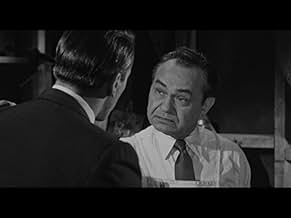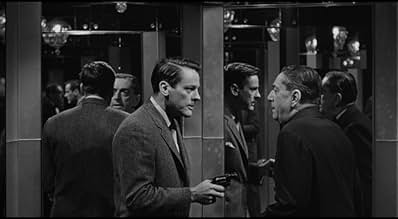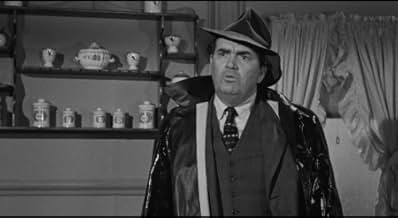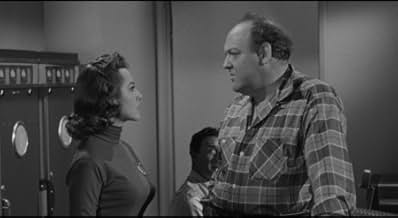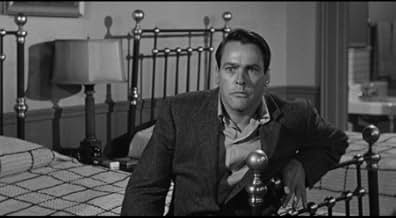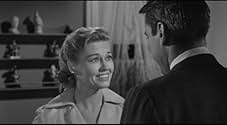IMDb RATING
6.4/10
1.4K
YOUR RATING
A New Orleans musician has a nightmare about killing a man in a strange house but he suspects that it really happened.A New Orleans musician has a nightmare about killing a man in a strange house but he suspects that it really happened.A New Orleans musician has a nightmare about killing a man in a strange house but he suspects that it really happened.
- Director
- Writers
- Stars
Ralph Brooks
- Oscar - the Bartender
- (uncredited)
Jack Chefe
- Nightclub Waiter
- (uncredited)
John Mitchum
- Onlooker at Stan's Suicide Attempt
- (uncredited)
Cosmo Sardo
- Nightclub Patron
- (uncredited)
- Director
- Writers
- All cast & crew
- Production, box office & more at IMDbPro
Featured reviews
Kevin McCarthy stars as a musician who wakes up one morning to find tangible evidence of something he thought he'd done in a dream. Things really gets going when good old Edward G. Robinson appears as the musician's brother-in-law who also just happens to be a police detective. There's just something about Eddie G. that compels us to watch him, whatever he's in.
McCarthy's character, Stan, thinks he may have committed a murder, and is tortured by the fact that he has no recollection of doing so, except in his "nightmare".He can't reconcile what he knows as reality with what he remembers from his dream and the evidence he found afterwards. (Intriguingly, a button and an odd-looking key.)
Oh, there's also a few female characters, none of them of the fatale variety. One of them is just a pick-up in a seedy all-night bar (interesting and kind of fun scene, though), the other two are his sister and his "girlfriend". I put girlfriend in quotation marks because Stan doesn't seem to have much regard for the poor girl, who's a jazz singer and devoted to him. Poor Gina, Stan has not the least interest in confiding his troubles to her, or in fact talking to her at all, as far as I could tell. He's always telling her he'll get back to her later, when he's straightened some things out.
Some noirs have a smart and sympathetic girlfriend or secretary (who of course later becomes the girlfriend) who helps the main character sort out his troubles, but Nightmare isn't one of those. It's all about Edward G. and his crime-solving abilities. But who's complaining when Edward G. solves or even commits a crime in any movie?
The story is set and filmed on location in New Orleans, which is a major strength of the film. There's one scene where Stan goes on a desperate search through the nightclubs and all-night bars of the city, trying to find a musician who's heard the mysterious melody he heard in his nightmare. I love all the neon lights flashing on and off, proclaiming the alluring names of the nightclubs - scenes like this are what noir is made of.
Another memorable scene is when Stan, the long-suffering Gina, and Edward G.Robinson and his wife (Stan's sister) go on a picnic and get caught in a rainstorm. They take refuge in a deserted house, where they light a fire and make themselves tea ! It just struck me as funny that they were making themselves so much at home in a complete stranger's house. Now, there is a reason for this, but that would be spoiler territory.
McCarthy's character, Stan, thinks he may have committed a murder, and is tortured by the fact that he has no recollection of doing so, except in his "nightmare".He can't reconcile what he knows as reality with what he remembers from his dream and the evidence he found afterwards. (Intriguingly, a button and an odd-looking key.)
Oh, there's also a few female characters, none of them of the fatale variety. One of them is just a pick-up in a seedy all-night bar (interesting and kind of fun scene, though), the other two are his sister and his "girlfriend". I put girlfriend in quotation marks because Stan doesn't seem to have much regard for the poor girl, who's a jazz singer and devoted to him. Poor Gina, Stan has not the least interest in confiding his troubles to her, or in fact talking to her at all, as far as I could tell. He's always telling her he'll get back to her later, when he's straightened some things out.
Some noirs have a smart and sympathetic girlfriend or secretary (who of course later becomes the girlfriend) who helps the main character sort out his troubles, but Nightmare isn't one of those. It's all about Edward G. and his crime-solving abilities. But who's complaining when Edward G. solves or even commits a crime in any movie?
The story is set and filmed on location in New Orleans, which is a major strength of the film. There's one scene where Stan goes on a desperate search through the nightclubs and all-night bars of the city, trying to find a musician who's heard the mysterious melody he heard in his nightmare. I love all the neon lights flashing on and off, proclaiming the alluring names of the nightclubs - scenes like this are what noir is made of.
Another memorable scene is when Stan, the long-suffering Gina, and Edward G.Robinson and his wife (Stan's sister) go on a picnic and get caught in a rainstorm. They take refuge in a deserted house, where they light a fire and make themselves tea ! It just struck me as funny that they were making themselves so much at home in a complete stranger's house. Now, there is a reason for this, but that would be spoiler territory.
In the late 1940s, director Maxwell Shane made a very low budget psychological thriller called Fear in the Dark -- about a man waking from a nightmare that he's murdered a stranger, only to find it to be true. In 1956, Shane decided to remake it as Nightmare, with a name cast (Kevin McCarthy -- Mary's brother, for the record -- as the luckless dreamer, Edward G. Robinson as his brother-in-law the homicide cop). It's a very close remake, not as pointlessly literal as Gus Van Sant's cloning of Psycho, but with little changed except a better and more integrated jazz score. In sum, Nightmare boasts better acting and better production values, all of which serve to point up the basic cheesiness of the plot. The earlier version, looking a lot like a nightmare itself, lends its own low-rent integrity to Cornell Woolrich's bizarre vision.
If you can get past the improbable key to the mystery, the rest of the movie has some good, strong points. The first twenty minutes plunge us into McCarthy's nightmarish events that may or may not have actually happened. We don't know for sure and neither does he, but there are the scratches on his arm. Did he kill those people or not. The surreal effects are impressively done.
McCarthy delivers a gripping performance, as good as Invasion of the Body Snatchers (also 1956), and much better than expected for a B-movie. In short, he makes us believe that his dilemma, however improbable, is real and not just a story construct. Without that intensity drawing us in, the movie would, I think, amount to little more than a mildly interesting walk-through.
The New Orleans locations provide a clever anchor to the real world, and a good setting for the colorful jazz scenes. However, a 63-year old Robinson is at least 10 years too old for the brother-in-law part even though he manages the cop role well. And can we really believe the chance occurrence onto the scene-of-the-crime mansion in all that unfamiliar backcountry. Unfortunately, the script requires more than just an ordinary suspension of disbelief. Too bad the script couldn't work in more bayou scenes. Those coming at the end are really creepy and nightmarish in their own right. Too bad also that the excellent McCarthy made so few films, preferring, I gather, stage productions instead. All in all, an interesting if regrettably flawed little movie.
McCarthy delivers a gripping performance, as good as Invasion of the Body Snatchers (also 1956), and much better than expected for a B-movie. In short, he makes us believe that his dilemma, however improbable, is real and not just a story construct. Without that intensity drawing us in, the movie would, I think, amount to little more than a mildly interesting walk-through.
The New Orleans locations provide a clever anchor to the real world, and a good setting for the colorful jazz scenes. However, a 63-year old Robinson is at least 10 years too old for the brother-in-law part even though he manages the cop role well. And can we really believe the chance occurrence onto the scene-of-the-crime mansion in all that unfamiliar backcountry. Unfortunately, the script requires more than just an ordinary suspension of disbelief. Too bad the script couldn't work in more bayou scenes. Those coming at the end are really creepy and nightmarish in their own right. Too bad also that the excellent McCarthy made so few films, preferring, I gather, stage productions instead. All in all, an interesting if regrettably flawed little movie.
Kevin McCarthy, a jazzman from New Orleans, has a nightmare. He dreams he was in a strange room and committed a murder, only to find out the next morning that there are clues he actually did it. Terrified, he goes to his brother-in-law (Edward G Robinson) to ask for help. Edward G doesn't believe him at first, but soon the evidence begins to pile up. The rest is too good to reveal. Kevin McCarthy's performance right on the heels of "Invasion of the Body Snatchers" is flawless - the terrified victim - again. Eddie G's character as the cynical, hard boiled homicide dick is one of his best. The story riveted me from start to finish and director Maxwell Shane set just the right tone. Watch for the final scenes in the mirrored room. The atmosphere shots of New Orleans in the 50's transports us back to another time. It's a mystery - a drama - a thriller. Do not miss it.
I had a feeling of deja vu as I watched this, and I soon realized it was a remake of Fear in the Night, a 1947 film starring DeForrest Kelley.
This film stars Edward G. Robinson, Kevin McCarthy, Virginia Christine, Connie Russell.
A young New Orleans jazz musician Stan (McCarthy) dreams that he's involved in a murder. He wakes up holding a button, a key, and he has blood on him. He's convinced he committed murder without realizing it. He approaches his brother-in-law Rene (Robinson), a police detective, who brushes it off as a nightmare.
One day, while on a picnic, Stan, Rene, Rene's wife (Christine) and Stan's girlfriend Gina (Russell) are caught in a rainstorm. Without realizing how he knows, Stan directs them to a house. There's a mirrored room as in his dream, and the key fits a closet.
Rene realizes that somehow Stan was involved and accuses him of lying and demanding to know the whole story. Stan swears it was all a dream, and he doesn't know what happened. When the sheriff comes along and tells them there was a murder in the house, Rene wants more information, believing Stan is a killer.
Neat story by Cornell Woolrich, who wrote "Rear Window." Edward G. Robinson is great as always as a man determined to get to the bottom of the mystery.
Kevin McCarthy, who worked until he died at 96, is adorable in this.
Some fantastic singing by Connie Russell -- it's worth watching the film just to hear her -- in what would be her last film. After a long career on stage, films, and clubs on two continents, she retired when she became a mom.
Very entertaining. The end is wonderful, and really puts it a cut above "Fear in the Night."
This film stars Edward G. Robinson, Kevin McCarthy, Virginia Christine, Connie Russell.
A young New Orleans jazz musician Stan (McCarthy) dreams that he's involved in a murder. He wakes up holding a button, a key, and he has blood on him. He's convinced he committed murder without realizing it. He approaches his brother-in-law Rene (Robinson), a police detective, who brushes it off as a nightmare.
One day, while on a picnic, Stan, Rene, Rene's wife (Christine) and Stan's girlfriend Gina (Russell) are caught in a rainstorm. Without realizing how he knows, Stan directs them to a house. There's a mirrored room as in his dream, and the key fits a closet.
Rene realizes that somehow Stan was involved and accuses him of lying and demanding to know the whole story. Stan swears it was all a dream, and he doesn't know what happened. When the sheriff comes along and tells them there was a murder in the house, Rene wants more information, believing Stan is a killer.
Neat story by Cornell Woolrich, who wrote "Rear Window." Edward G. Robinson is great as always as a man determined to get to the bottom of the mystery.
Kevin McCarthy, who worked until he died at 96, is adorable in this.
Some fantastic singing by Connie Russell -- it's worth watching the film just to hear her -- in what would be her last film. After a long career on stage, films, and clubs on two continents, she retired when she became a mom.
Very entertaining. The end is wonderful, and really puts it a cut above "Fear in the Night."
Did you know
- TriviaWhen Stan goes out walking the morning after his nightmare, he passes by a place with a sign that says "New Orleans' Most Famous Coffee Drinking Place." That would be the Morning Call Coffee Stand that was on Decatur Street in the French Quarter. Opened in 1870, it moved to Metairie in 1974.
- GoofsAccording to the elevator there are only 15 floors in the hotel, but the shot of the building from outside shows more than fifteen.
- Quotes
[first lines]
Stan Grayson: At first, all I could see was this face, this beautiful babe's face, floating toward me. And in my head, was this slow, crazy melody - like a tune from another world. And then a I saw the room - a queer mirrored room. And somehow, I was inside of it. There was danger there. I knew that.
- ConnectionsFeatured in Out of this World Super Shock Show (2007)
- SoundtracksWhat's Your Sad Story
Words and Music by Richard M. Sherman (as Dick Sherman)
Performed by Connie Russell / Billy May Orchestra
- How long is Nightmare?Powered by Alexa
Details
- Runtime1 hour 29 minutes
- Color
Contribute to this page
Suggest an edit or add missing content

